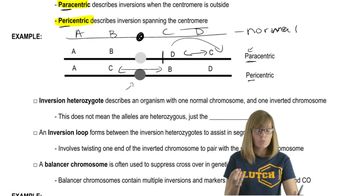Contrast the genetic composition of gametes derived from tetrads of inversion heterozygotes where crossing over occurs within a paracentric versus a pericentric inversion.
Table of contents
- 1. Introduction to Genetics51m
- 2. Mendel's Laws of Inheritance3h 37m
- 3. Extensions to Mendelian Inheritance2h 41m
- 4. Genetic Mapping and Linkage2h 28m
- 5. Genetics of Bacteria and Viruses1h 21m
- 6. Chromosomal Variation1h 48m
- 7. DNA and Chromosome Structure56m
- 8. DNA Replication1h 10m
- 9. Mitosis and Meiosis1h 34m
- 10. Transcription1h 0m
- 11. Translation58m
- 12. Gene Regulation in Prokaryotes1h 19m
- 13. Gene Regulation in Eukaryotes44m
- 14. Genetic Control of Development44m
- 15. Genomes and Genomics1h 50m
- 16. Transposable Elements47m
- 17. Mutation, Repair, and Recombination1h 6m
- 18. Molecular Genetic Tools19m
- 19. Cancer Genetics29m
- 20. Quantitative Genetics1h 26m
- 21. Population Genetics50m
- 22. Evolutionary Genetics29m
6. Chromosomal Variation
Chromosomal Rearrangements: Inversions
Problem 22c
Textbook Question
A couple planning their family are aware that through the past three generations on the husband's side a substantial number of stillbirths have occurred and several malformed babies were born who died early in childhood. The wife has studied genetics and urges her husband to visit a genetic counseling clinic, where a complete karyotype-banding analysis is performed. Although the tests show that he has a normal complement of 46 chromosomes, banding analysis reveals that one member of the chromosome 1 pair (in group A) contains an inversion covering 70 percent of its length. The homolog of chromosome 1 and all other chromosomes show the normal banding sequence. Would you advise the woman that she will have to bring each pregnancy to term to determine whether the fetus is normal? If not, what else can you suggest?
 Verified step by step guidance
Verified step by step guidance1
Understand the problem: The husband has a chromosomal inversion on one of his chromosome 1 pair, which could lead to complications in offspring due to improper segregation during meiosis. This can result in unbalanced gametes, potentially causing stillbirths or malformed offspring. The question is whether the woman must bring each pregnancy to term to determine if the fetus is normal, or if there are alternative options.
Explain the concept of chromosomal inversion: A chromosomal inversion occurs when a segment of a chromosome is reversed end to end. If the inversion does not disrupt any genes, the individual (like the husband) may be phenotypically normal but can produce gametes with unbalanced genetic material during meiosis due to improper pairing and crossing over.
Discuss the role of genetic counseling and prenatal testing: Advise the couple that they do not need to bring each pregnancy to term to determine if the fetus is normal. Instead, they can use prenatal diagnostic techniques such as chorionic villus sampling (CVS) or amniocentesis to analyze the fetus's karyotype and detect any chromosomal abnormalities early in pregnancy.
Introduce preimplantation genetic testing (PGT): Suggest that the couple consider in vitro fertilization (IVF) combined with preimplantation genetic testing. This allows embryos to be screened for chromosomal abnormalities before implantation, ensuring that only embryos with a normal karyotype are implanted.
Summarize the options: The couple has several alternatives to bringing each pregnancy to term, including prenatal diagnostic testing (CVS or amniocentesis) and preimplantation genetic testing (PGT) with IVF. These methods can help identify chromosomal abnormalities early and allow for informed decision-making about the pregnancy.
 Verified video answer for a similar problem:
Verified video answer for a similar problem:This video solution was recommended by our tutors as helpful for the problem above
Video duration:
6mPlay a video:
Was this helpful?
Key Concepts
Here are the essential concepts you must grasp in order to answer the question correctly.
Chromosomal Inversions
A chromosomal inversion occurs when a segment of a chromosome is reversed end to end. This can disrupt gene function and may lead to reproductive issues, such as miscarriages or congenital abnormalities. In this case, the husband's chromosome 1 has a significant inversion, which could affect the viability of embryos and the health of potential offspring.
Recommended video:
Guided course

Inversions
Karyotype Analysis
Karyotype analysis is a laboratory technique that visualizes an individual's chromosomes to assess their number and structure. It helps identify chromosomal abnormalities, such as aneuploidy or structural changes like inversions. In this scenario, the normal karyotype indicates that the husband has the typical number of chromosomes, but the inversion on chromosome 1 is a critical finding that may influence genetic counseling and reproductive decisions.
Recommended video:
Guided course

Chi Square Analysis
Genetic Counseling
Genetic counseling is a process that provides individuals or couples with information about genetic conditions and the risks of passing them on to their children. It involves assessing family history, discussing potential genetic tests, and exploring reproductive options. Given the husband's chromosomal inversion and the family's history of stillbirths and malformations, genetic counseling can help the couple understand their risks and make informed decisions about family planning.
Recommended video:
Guided course

Descriptive Genetics
Related Videos
Related Practice
Textbook Question
785
views


